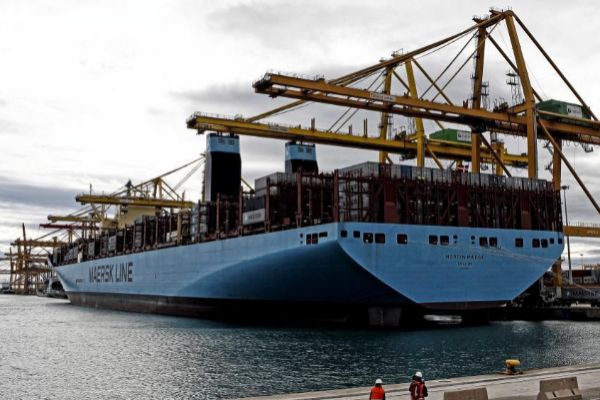- History: The sinking of Essex and the cannibals of Moby Dick
- The 'Balearic Islands' The 'supervillain' who starred in Franco's worst film
- Leslie Howard.Churchill, Hitler, Franco and the actor of 'What the wind took away' that could change World War II
- HMS Terror.The ship of polar explorers who ended up losing and devouring each other
It is easier to describe the sinking of the MOL Comfort than to imagine it afloat , but let's try. Standing at his feet was like standing under a steel cliff. As if you put yourself in a box office of the Santiago Bernabéu or the Camp Nou and look towards the top of your stands, only you would still have a third to reach the height of the boat.
If it is impossible to imagine a Bernabéu or a floating Camp Nou, with its 105 meters of goal to goal, what about the 316 of the MOL Comfort. And even more if we think of what forces of nature make him descend waves like slides, and impact tides that propel the water above the load, with his crew moving with ropes and harnesses as if the sea, every second, made them Climb and descend a mountain. It was an engineering prodigy that doubled like a dock , but it split in half like a chocolate bar.
The wreck of container ships, but especially containers, is, at the same level as giant squid, one of the best kept secrets of the oceans . There are currently 6,000 ships in the oceans with 20 million containers that go around the world with 90% of the goods we consume.
A report by the Surfrider Europe Foundation recorded 673 accidents between 1990 and 2015 , with 13,410 containers dumped into the sea. There were the 117 drawers with BMW motorcycles from the NSC Napoli that ended up on the coast of Bramscombe, in the United Kingdom; or the 74 wine from the MSC Carla that ended up in the Azores; or the 520 of Svenborg Maersk cigarettes that ended up in Brittany. The World Shipping Council (WSC), the employer of this matter, recognized many more shortly after. About 1,679 annual containers lost on average.
On its last trip, the MOL Comfort was half-loaded, carrying 4,382 containers, enough for its unknown cargo to be the biggest loss in history.
The ship was built in Japan in 2008 , and baptized as APL Russia. But it changed its name in June 2012, a year before its sinking. At the time of the accident it covered the route from Singapore to Jeddah, in Saudi Arabia. In addition to the containers, a crew consisting of 11 Russians, a Ukrainian and 14 Filipinos was traveling. They came out unharmed.
On June 17, 2013, while sailing 370 kilometers off the coast of Yemen, in the middle of a storm that experts said could leave without problems, it broke in half. The wreck was very slow, televised, as if in slow motion . It lasted almost a month, until July 11. The crew was rescued by another container ship, while the two pieces of ship separated, and continued sailing on their own, loaded with containers.
On June 27 the stern sank to 4,000 meters deep. Little by little he began to sting and the containers, with their mysterious content, fell into the sea like a giant train from a viaduct, and then began to sail like colored whales. Sooner or later, many open up and throw their cargo into the sea as happened with the rubber ducklings of the Ever Laurel that launched into the sea on January 10, 1992, south of the Aleutians. His case allowed studying the currents of the Pacific .
Before the loss of Comfort containers, the most famous was that of the China APL, which made the Taiwan-Seattle route. In the real world, if one is delayed by the slippers he requested online, what he receives is a mail delayed in the delivery of his order; But when we talk about tens of thousands of shoes, and many other things, it is normal that it ends up like the APL China, with a judicial process with 361 claimants, 25 lawyers and one hundred million dollars in damages .
China followed the meteorologist's instructions and changed the route and that decision made him lose more than 400 containers , and enter Seattle with the rest twisted as if they were made of foil, or crushed like cookies; and with the deck full of bicycles, melons, remote control boats, golf clubs, frozen lobster tails, plastic air fresheners, labels for sewing on clothes, music equipment, stainless steel pots, plastic flower bouquets, pants . "Whatever the Americans consumed at that time was there," stevedor Dan McKisson tells journalist Donovan Hohn.
Let's go back to the Comfort. On July 6, his bow was still sailing with 2,400 containers on board which, for unknown reasons, began to burn. And so it was for five days, until it ended up also plunging into the Indian Ocean. The losses were estimated by the insurers between 300 and 400 million dollars .
The Comfort accident opened a debate about the size of ships, and another about engineering, and another about weather forecasts, and another about routes that should be avoided. Debates that rescue what 200 years ago Melville wrote in Moby Dick : "As much as in a future flattering may increase that science and skill, however, for ever and ever, until the sinking of judgment, the sea will continue to insult him and killing him, and pulverizing the most solemn and rigid frigate he can make. "
According to the criteria of The Trust Project
Know more- culture
- history
Literature: John Kennedy Toole, Misadventures of a Clumsy Lover
History Churchill, Hitler, Franco and the actor of 'What the wind took away' that could change World War II
CulturaPérez Henares: "We don't have to apologize for discovering America"

